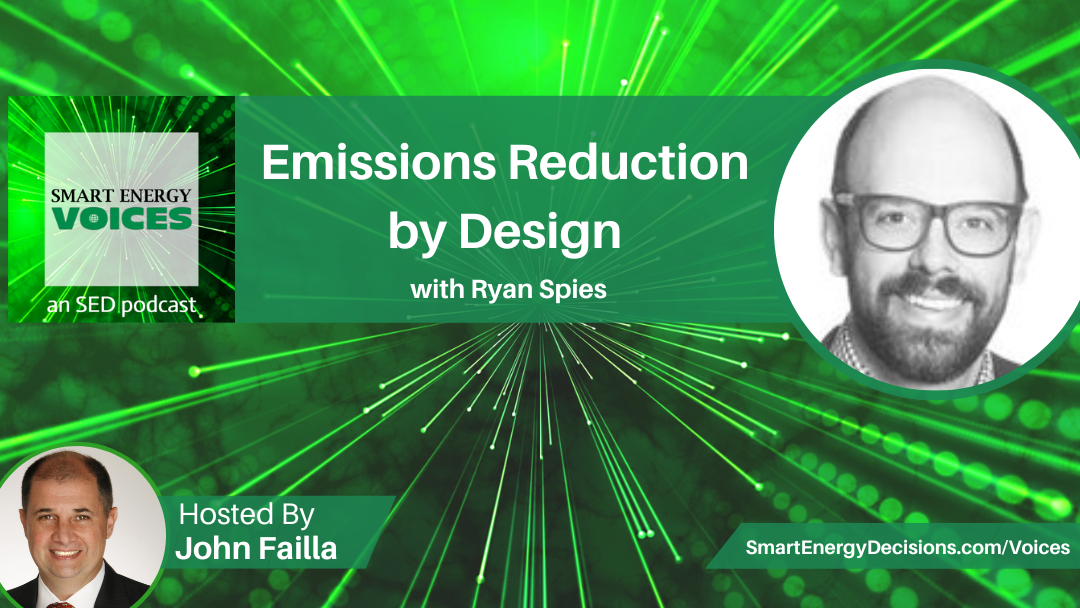Smart Energy Voices- Episode 71
Emissions Reduction by Design
Listen on your Preferred Podcast Player »
In this episode of Smart Energy Voices, host John Failla introduces Ryan Spies, Vice President of Sustainability at Clayco. As the closing keynote speaker from Smart Energy Decisions’ Renewable Energy Forum, Ryan spoke about addressing emissions reduction through design and the role renewables should play in decarbonization strategies.
You will want to hear this episode if you are interested in...
- Ryan’s role at Clayco [01:52]
- Focusing on building [03:15]
- Embodied carbon [06:10]
- Concrete and steel [08:38]
Designing for net-zero
Building, materials, and construction account for a massive portion of the energy and emissions associated with everything people do. While the primary focus for emissions reduction has been on operations, the next critical step is to focus on building materials and construction. Clayco builds in ways that make the buildings inherently more energy efficient. Designing this way allows a company’s procurement department to contribute to climate action goals.
Some organizations have goals for electrification and emissions reductions for 2030 and 2040, yet they still have buildings built for natural gas. Many markets will be able to be electrified relatively simply, so preparing for that change makes sense. Geothermal makes sense in various markets as well. While the initial investment may be more costly, operational expenses will be reduced. Another consideration is solar energy, so a building’s design can also include solar panels, while a large roof can offer an incredible solar opportunity. Even if a company isn’t using all the energy provided, the company can contribute to community solar.
Embodied carbon
Embodied carbon reduction has taken off in popularity over the last few years. The term encompasses the energy and footprint that goes into a building, from making and using materials to transportation to the site. For most organizations, these components would be considered Scope 3. A long-lasting impact can be had on this level when the changes are made at the designing stage. The impact of changes made in a building’s design will last for decades.
Scope 3 emissions have been receiving more attention lately because new ways of measuring have been created. Life-cycle assessments(LCAs) determine the environmental impact of all stages of a product. The next piece of the LCA is an environmental product declaration, which is essentially a cheat sheet for the carbon footprint of a product. Making an informed decision about manufacturing materials is now easier than ever before.
Using data for better choices
Manufacturers are looking for solutions to the two most significant influences on carbon footprint in building: concrete and steel. Clayco’s modelers and architecture firm utilize the available data with an EC3 tool to aggregate all the available PDS. They create a model and enter it into the system to highlight the hot zones and determine where they can make changes.
Not all changes have to cost more. Some decisions are cost-neutral, only requiring a better decision. Everyone is competing on costs. If two products are relatively equal, choosing the manufacturer with the lower footprint will push the higher one to do more. A standard building with standard drywall can show almost a 50% reduction by making smarter choices. These choices are no different than what is done in a renewables plan. Engaging suppliers, experts, and people in this part of the process will result in significant carbon reduction.
Resources & People Mentioned
- Clayco
- Zurich North America Headquarters
- Saint-Gobain to Invest $91 Million in its Montreal Gypsum Plant
Connect with Ryan Spies
- Smart Energy Decisions
-
Follow us on LinkedIn
Subscribe to Smart Energy Voices on
Apple Podcasts, Google Podcasts, Android, Spotify, Stitcher, TuneIn Radio, aCast, PlayerFM, iHeart RadioIf you're interested in participating in the next Smart Energy Decision Event, visit smartenergydecisions.com or email our Community Development team at [email protected]












